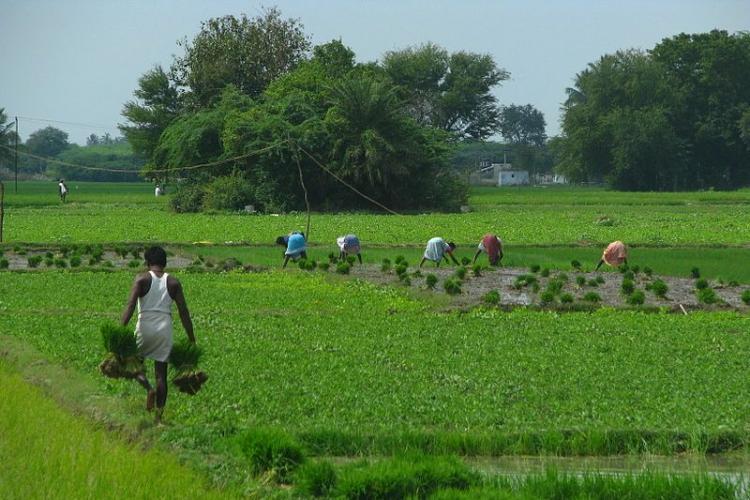Land Reform: A Plant Uprooted Before It Could Bear Fruit

Representational image. Image Courtesy: The News Minute
How realistic can any promise be if the most effective means of achieving it has been discarded deliberately? In the case of promises and highly-exaggerated claims of reducing rural poverty, it should be questioned how real these are when the most promising means of land reforms has been given up before achieving any real and significant success in its implementation.
Land reforms have been widely regarded all over world as an important source of reducing rural inequality and poverty. While the importance of land reform was well-recognised in early post-independence years, unfortunately, they were more or less given up before they could make a significant and meaningful contribution. Now this failure appears to be more complete than ever before as the agenda of redistributing land among the landless has been given up entirely.
When it comes to finding land for the rural landless it is said that land is just not available but it does become available in plenty when the aim is to find land for big corporates. Land redistribution in favour of the landless and nearly-landless people is just not on the agenda of the present-day political establishment.
Despite this highly discouraging and unhelpful attitude of recent government policy it is important to re-emphasise the importance of land reform not just for reducing poverty but also for widening the base for increasing farm production and productivity in the country and improving overall food security and sovereignty. While discussing future food and farming trends the Food and Agriculture Organization (FAO) of the United Nations has emphasised in a report on agriculture that more equal land distribution is likely to increase the productivity of land: “With a few notable exceptions, total output per hectare is higher on small farms, chiefly because their intensity of land use is higher.” The FAO said that the contribution of land reforms to reducing poverty is even more significant. “Redistribution of only 5% of farmland in India, coupled with improved access to water, could reduce rural poverty levels by 30%… so that in Indian conditions land and water reform would be a key approach.”
This view is supported by a six-country study by the International Labour Organization (ILO) which estimated, “If land were equally distributed among all agricultural families (including the landless), and the new equal holdings achieved yields equal to present holdings of the same size and used a similar level of inputs, food output could potentially rise by anything from 10% (Pakistan) and 28% (Colombia and a rice-growing Malaysian region) to 80% in northeastern Brazil.”
India’s Planning Commission had also agreed that land reform plays a key role, stating, “In an economy where over 60 percent of the population is dependent on agriculture, the structure of land ownership is central to the well-being of the people.” Despite this the Planning Commission also noted the decline in the commitment to land reforms, “Land reforms seem to have been relegated to the background in the mid 1990s. More recently, initiatives of state governments have related to liberalising of land laws in order to promote large-scale corporate farming.” Accordingly, in volume 2 of the Tenth Five-Year Plan document, the erstwhile Planning Commission had emphasised that between 2002-07, India “will ensure effective implementation of land reform legislations, ceiling and distribution of surplus land and issue of joint pattas under government schemes etc.”
The report of the Working Group on Land Relations for Formulation of the Eleventh Five Year Plan then had stated even more frankly, “There are serious concerns that the phase of economic liberalisation may be accompanied by further erosion of land-reforms.” Pushpendra, a researcher with the Lal Bahadur Shastri Academy had expressed regret that “the pro-liberalization lobby is for the removal of all restrictions on leasing, upward revision of ceilings on holdings, concessions to the industry for investing in rural infrastructure, unrestricted entry in rural areas for national and multinational companies, agro-farm houses, food and fruit processing industries to lease-in or purchase land through direct interaction with the peasants, speeding-up the acquisition process by the government, export-led and demand-driven agriculture, and for the removal of all restrictions on conversion of land from farm to non-farm activities.” He had also noted the “immense pressure” on the government to make available land to private parties either through acquisition or from its own pool of land “meant for distribution to the landless and the small and marginal farmers.”
Once the neo-liberal agenda got well entrenched in India in the 1990s, for all practical purposes, the land reform program entered the process of being withdrawn. This happened without any significant redistribution being achieved in favour of the poor. Former secretary to the government of India SR Sankaran, the senior-most rural development official of the country, who is known for his forthright views, wrote, “…the extent of land redistributed was 43% of agricultural land in China, 37% in Taiwan, 32% in South Korea and 33% in Japan, whereas in India, the efforts of the central and state governments to enact, revise and implement the ceiling laws, spread over 35 years, resulted in the redistribution of only 1.25% cent of the operational area.”
Although in public pronouncements the government placed special emphasis on preventing alienation of tribal communities from their land, here too reality differed from rhetoric. As a review by another senior official, Sukumar Das, stated, “Land legislation to protect the tribal people has failed to achieve its basic objective. In fact, more than 50% of the total land allotted by the government has already been alienated.” What is more, land acquisition for various projects over the years resulted in tribal communities becoming the biggest losers of land.
There was some hope when over 2005-08 the Scheduled Tribes and Traditional Forest Dwellers Forest Rights Act (known as the Forest Rights Act or simply FRA) was passed and its rules framed. This Act hoped to correct the historical injustice that had been caused to tribal and other forest-dweller communities. But this hope, too, was belied to a significant extent due to several factors. First, the number of rejection of claims was very high. Often, those whose claim was rejected were often not even informed about it. Second, a significant number of deserving households were simply left out as they could not send their claims properly in time. Even in the case of those whose claims were accepted, often the acceptance was only for a small part of land being cultivated earlier.
Hence despite lip service to reducing rural poverty, perhaps the program of greatest potential for this objective has been given up even before any real or significant success was achieved. However, it remains extremely important to keep land reforms on the agenda of rural development and change. It has been seen time and again that even small plots of land allotted to landless households, even if used just as kitchen gardens, can contribute significantly to improving nutrition and food security for the poorest households.
Where land needs to be under tree cover for ecological reasons, giving legal rights to the landless over these tracts, which can be sown with mixed species of indigenous trees using their wage labour, can be beneficial. Rights over minor forest produce that is harvested on a sustainable basis makes wage labour remunerative. Even work done under MG-NREGA can be used to fence degraded land. Regenerated forests can also be a source of income for the landless, provided they are restored their rights over minor forest produce.
Even modest schemes have potential to combine ecological needs with more land and livelihood rights for the poorest. Redistribution efforts on a wider scale, of course, can bring greater benefits. This also gives landless people more stability in the overall rural structure. Hence, instead of being brushed aside rudely, or diverted from, the agenda of land reforms should be strongly protected and promoted.
The writer is a freelance journalist who has been involved with several social movements. The views are personal.
Get the latest reports & analysis with people's perspective on Protests, movements & deep analytical videos, discussions of the current affairs in your Telegram app. Subscribe to NewsClick's Telegram channel & get Real-Time updates on stories, as they get published on our website.
























